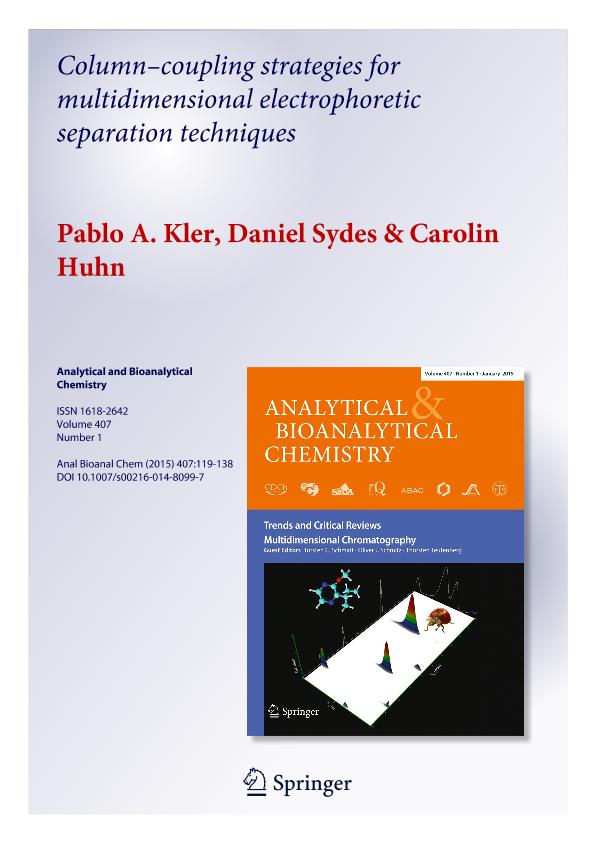Mostrar el registro sencillo del ítem
dc.contributor.author
Kler, Pablo Alejandro

dc.contributor.author
Sydes, Daniel
dc.contributor.author
Huhn, Carolin
dc.date.available
2019-06-21T01:24:18Z
dc.date.issued
2015-01
dc.identifier.citation
Kler, Pablo Alejandro; Sydes, Daniel; Huhn, Carolin; Column--coupling strategies for multidimensional electrophoretic separations; Springer Heidelberg; Analytical and Bioanalytical Chemistry; 407; 1; 1-2015; 119-138
dc.identifier.issn
1618-2642
dc.identifier.uri
http://hdl.handle.net/11336/78610
dc.description.abstract
Multidimensional electrophoretic separations represent one of the most common strategies for dealing with the analysis of complex samples. In recent years we have been witnessing the explosive growth of separation techniques for the analysis of complex samples in applications ranging from life sciences to industry. In this sense, electrophoretic separations offer several strategic advantages such as excellent separation efficiency, different methods with a broad range of separation mechanisms, and low liquid consumption generating less waste effluents and lower costs per analysis, among others. Despite their impressive separation efficiency, multidimensional electrophoretic separations present some drawbacks that have delayed their extensive use: the volumes of the columns, and consequently of the injected sample, are significantly smaller compared to other analytical techniques, thus the coupling interfaces between two separations components must be very efficient in terms of providing geometrical precision with low dead volume. Likewise, very sensitive detection systems are required. Additionally, in electrophoretic separation techniques, the surface properties of the columns play a fundamental role for electroosmosis as well as the unwanted adsorption of proteins or other complex biomolecules. In this sense the requirements for an efficient coupling for electrophoretic separation techniques involve several aspects related to microfluidics and physicochemical interactions of the electrolyte solutions and the solid capillary walls. It is interesting to see how these multidimensional electrophoretic separation techniques have been used jointly with different detection techniques, for intermediate detection as well as for final identification and quantification, particularly important in the case of mass spectrometry. In this work we present a critical review about the different strategies for coupling two or more electrophoretic separation techniques and the different intermediate and final detection methods implemented for such separations.
dc.format
application/pdf
dc.language.iso
eng
dc.publisher
Springer Heidelberg

dc.rights
info:eu-repo/semantics/openAccess
dc.rights.uri
https://creativecommons.org/licenses/by-nc-sa/2.5/ar/
dc.subject
Column-Coupling
dc.subject
Isolectric Focusing
dc.subject
Isotachophoresis
dc.subject
Mass Spectrometry
dc.subject
Multidimensional Electrophoretic Separations
dc.subject.classification
Otras Ciencias Químicas

dc.subject.classification
Ciencias Químicas

dc.subject.classification
CIENCIAS NATURALES Y EXACTAS

dc.title
Column--coupling strategies for multidimensional electrophoretic separations
dc.type
info:eu-repo/semantics/article
dc.type
info:ar-repo/semantics/artículo
dc.type
info:eu-repo/semantics/publishedVersion
dc.date.updated
2019-06-19T16:53:50Z
dc.journal.volume
407
dc.journal.number
1
dc.journal.pagination
119-138
dc.journal.pais
Alemania

dc.journal.ciudad
HEIDELBERG
dc.description.fil
Fil: Kler, Pablo Alejandro. Consejo Nacional de Investigaciones Científicas y Técnicas. Centro Científico Tecnológico Conicet - Santa Fe. Centro de Investigaciones en Métodos Computacionales. Universidad Nacional del Litoral. Centro de Investigaciones en Métodos Computacionales; Argentina
dc.description.fil
Fil: Sydes, Daniel. Universität Tübingen; Alemania
dc.description.fil
Fil: Huhn, Carolin. Universität Tübingen; Alemania
dc.journal.title
Analytical and Bioanalytical Chemistry

dc.relation.alternativeid
info:eu-repo/semantics/altIdentifier/doi/http://dx.doi.org/10.1007/s00216-014-8099-7
Archivos asociados
